What do gongs, long hair and chewing gums have in common?
They were all part of a list of items that were either permanently banned or disallowed in public for a period of time in Singapore. Some banned items contained dangerous elements, while others were associated with excessive contents of sex and violence that challenged the society’s moral standards. Banning of certain publications was common. For example, a Hong Kong comic, popular among Singapore students who would spend their pocket money to buy at the roadside stalls, was banned in 1966 due to its undesirable storyline filled with violence, gangsterism and fantasy.
So other than drugs and gambling, what had been banned in Singapore since the sixties?
Playboy Magazines
As part of the “anti-yellow” drive at the start of 1960, the Playboy magazine and its Playmate calender was officially banned in Singapore. Costing $2.10 per copy, the monthly magazine from Chicago fell under the provisions of the Undesirable Publications Ordnance. It never made it to Singapore shores since.
Three years later in 1963, thirty more “morally objectionable” novels from the United States, with contents mostly describing sex and violence, were banned by the Home Affairs Ministry.
Gongs and Cymbals
 In early 1960, the Singapore police banned gongs and cymbals at Chinese wakes and funerals. A Chinese tradition for centuries, the shattering noise of gongs and cymbals had been an integrated part of Chinese wakes that were accompanied by bands and funeral music. In the fifties, however, secret societies began to infiltrate Chinese clans and associations that increased the rivalries between one another.
In early 1960, the Singapore police banned gongs and cymbals at Chinese wakes and funerals. A Chinese tradition for centuries, the shattering noise of gongs and cymbals had been an integrated part of Chinese wakes that were accompanied by bands and funeral music. In the fifties, however, secret societies began to infiltrate Chinese clans and associations that increased the rivalries between one another.
The tensions were especially high during the funerals, where rival societies tried to “out-gong” each other, often resulting in fights and melees. Beside the ban, the police also ordered the funeral bands to take the shortest routes from the deceased’s houses to the cemeteries in order to minimise the possible friction between the gangs. The ban was only lifted many years later.
Firearms
Singapore is a relatively safe place today with the public not allowed to possess any forms of firearms, but it was not the same during the fifties, when post-war Singapore was in the midst of the Malayan Emergency (1948-1960). Thousands of weapons and permits were issued to individual private owners for protective purposes.
On 15 July 1960, three days after the official ending of Malayan Emergency, the Singapore police began to cancel the licenses and inform the private firearm owners to hand over their weapons. Those who failed to do so within three weeks had to justify their reasons.
Tikam Tikam
 The chance game of tikam tikam was outlawed by the police in 1961. Offenders caught playing the game would be fined $500 and jailed up to 6 months, while the tikam tikam operators faced a fine of $6,000 and a 3-year imprisonment. The harsh punishment, however, failed to deter the the public from engaging in the popular game at places such as Chinatown, Tiong Bahru and New Bridge Road.
The chance game of tikam tikam was outlawed by the police in 1961. Offenders caught playing the game would be fined $500 and jailed up to 6 months, while the tikam tikam operators faced a fine of $6,000 and a 3-year imprisonment. The harsh punishment, however, failed to deter the the public from engaging in the popular game at places such as Chinatown, Tiong Bahru and New Bridge Road.
At five cents per pick, the punter could pick a piece of paper with a number written on it. With prizes ranging from toys to packets of cigarettes, and sometimes cash, it often attracted many to gather at the tikam tikam stalls outside the schools, markets and Chinese operas. Despite the ban, the game of chance remained popular among Singaporeans until the eighties.
Pirate Taxis
In a major crackdown known as “Operation Taxi” in 1966, as many as 20 illegal taxis were chong gong (confiscated) with their drivers arrested and fined. The problem of pirate taxis had already existed in the fifties, but by the mid-sixties, there were more than 12,000 pirate taxi drivers in Singapore, offering competitive rates and “stealing” an estimated of 6 million ridership from the Singapore Traction Company’s bus services. Many being new drivers without regular driving experiences, they also added to the increasing number of accidents on the roads, complicating insurance matters.
To make things worse, many pirate taxi drivers had the backing of the secret societies, and had marked their territories in areas such as Queenstown, Aljunied and Havelock Road where few licensed taxi drivers dared to venture in to pick up passengers. In March 1966, a riot almost broke out as the illegal drivers protested against the new legislation, almost clashing with the licensed drivers and the bus companies.
In a bid to overhaul the public transport service, the government increased the number of legitimate taxis from 3,800 to 5,000 in 1969. Despite the ban and regular raids, pirate taxis continued to exist in Singapore until the eighties.
Firecrackers
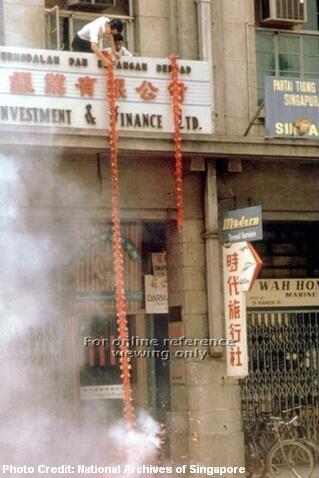 The year was 1968. Few had paid attention to the government’s repeated appeals not to let off the rocket-type firecrackers during the Chinese New Year. It resulted in the banning of the rocket-type firecrackers, but that did not stop the public from using other types of firecrackers in strings and packets.
The year was 1968. Few had paid attention to the government’s repeated appeals not to let off the rocket-type firecrackers during the Chinese New Year. It resulted in the banning of the rocket-type firecrackers, but that did not stop the public from using other types of firecrackers in strings and packets.
A partial ban of all types of firecrackers was issued after 6 people died and more than 70 were injured from the fires caused by firecrackers during the 1970 Chinese New Year. The final straw came two years later, when two policemen were attacked as they tried to stop a group of men letting off firecrackers at a non-designated place. The firecrackers were totally banned in Singapore in 1972.
Long Hair
In the late sixties, long hair, bell bottoms and psychedelic shirts were largely associated with the hippie culture influenced by the Western world. The Singapore government began to strongly “discourage” male Singaporeans with long hair in 1970. Visitors to the country were turned away due to their long hairs. Students were made to go for haircuts, civil servants who refused to cut their hairs short were sacked and groups of long-haired men were rounded up and questioned by the police.
 In 1973, the People’s Association launched the anti-long hair campaign in all of its 189 community centres, emphasizing that “males with long hair will have their need attended to last” when they visited government bodies. The definition of long hair was determined as hair reaching below the collar, covering the ears and forehead and touching the eyelashes.
In 1973, the People’s Association launched the anti-long hair campaign in all of its 189 community centres, emphasizing that “males with long hair will have their need attended to last” when they visited government bodies. The definition of long hair was determined as hair reaching below the collar, covering the ears and forehead and touching the eyelashes.
Popular artistes, such as Japanese musician Kitaro and British rock band Led Zeppelin, were also barred from entering Singapore. The baffling rule was eventually, and quietly, lifted when the hippie culture faded away by the eighties.
Nunchaku
Nunchaku, the martial art weapon made up of two hard wood rods linked together by a chain, was made popular by Bruce Lee’s films in the early seventies. It was used in karate classes in Singapore, and was even advertised in newspapers.
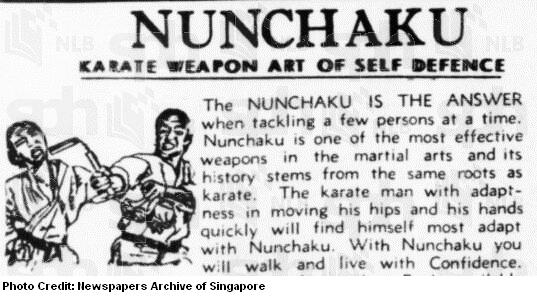
But by 1972, it was deemed as an offensive weapon and was banned in Singapore, believed to be part of the cracking down efforts of secret society members. In 1975, a 23-year-old man named Sethupillay Rajaretnam became the first man in Singapore to be jailed and caned for possessing nunchaku. Several youths carrying nunchaku were also subsequently arrested and charged in the court.
Hell-riders
“Black Coffins”, “Jacky’s Trails”, “Scorpio”, “White Snake” and “Hell’s Angels”. These were the names hell-riding groups had given themselves in the early seventies. More than just public nuisance, many hell-riders were involved in gambling, drug-taking, gang fights and, worst of all, fatal accidents. In 1982 alone, almost 80 died and more than 4,500 were injured in motorcycle accidents. In the high-speed races, it was not uncommon to read in the newspapers that a Yamaha Daytona had crashed and dragged to the roadside, with its owner lying elsewhere in a twisted manner.
After the new anti-hell-riding laws were passed in the early eighties, the Singapore police carried out a major crackdown in October 1984 at Nicoll Drive, checking on some 500 vehicles in the four-hour operation. Popular illegal racing spots at Changi and Jurong were kept quiet for more than a year, leading to the police to proudly declare that organised hell-riding was a thing of the past.
Breakdancing
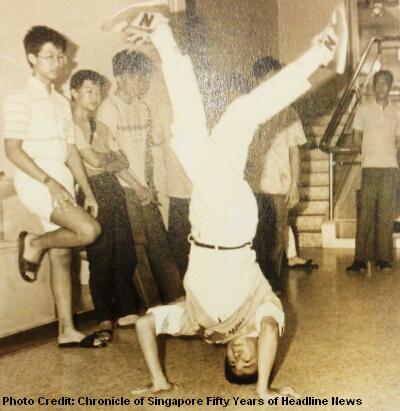 The eighties saw the rise of funky youths dressed in outrageous outfits and carrying portable hi-fi sets at Orchard Road. Popularly known as the Far East Plaza Kids, McDonald’s Kids or the Centrepoint’s Kids, they could be spotted hanging out outside the popular shopping malls, sometimes in groups of hundreds.
The eighties saw the rise of funky youths dressed in outrageous outfits and carrying portable hi-fi sets at Orchard Road. Popularly known as the Far East Plaza Kids, McDonald’s Kids or the Centrepoint’s Kids, they could be spotted hanging out outside the popular shopping malls, sometimes in groups of hundreds.
In June 1984, police task-force troops were called in to disperse a huge group of youngsters at Far East Plaza. A breakdancing performance had been organised by a record shop, attracting as many as 3,000 youngsters to gather and cheer. A week later, the police officially banned breakdancing in public places.
Chewing Gums
One of the most well-known items banned in Singapore, chewing gums were deemed as a public nuisance after repeated cases of disruptions to the MRT trains and buses. Every night, more than 400 globs of chewing gums, on average, were removed from the seats inside the MRT trains.

In November 1989, chewing gums were officially prohibited in MRT trains and stations. The ban was extended to nationwide in January 1992, due to the increasing cost of removing discarded gums stuck on pavements, lift doors and other public places. The majority of the Singaporeans felt that the ban was too harsh, although many would agree that chewing gum was an irritation and public nuisance. It would take many years before certain gums were allowed to be sold in Singapore as medical products.
Published: 19 June 2014


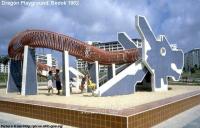

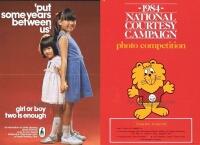



Thanks for sharing. I’ve never knew long hair were once banned in Singapore! Haha
one I like is the banning of chewing gum. The place looks very neat and I was surprised to hear about this banning long back in the year 2000 when i was in singapore, thought my friend was bluffing when I heard it 1st time.
I like the banning of firearms! We should have that in the US!
I don’t understand where they were going with that to ban breakdancing, chewing gum, and long hair.
Very informative post! I’ve always wanted to travel to Singapore. Hopefully sometime soon! I might need a haircut first, though ;P
An Australian friend of mine shared the story of his first visit to Singapore several decades ago. After getting off the plane and waiting for his turn in the immigration area, an official informed him that his hair was too long to enter the country. He was given the choice to return to Australia or get a free haircut right there at the airport. He chose the free haircut…
Ha ha reminds me of a friend with many children who was not allowed to bring a jar of peanut butter onto the plane. She sat down then and there and made it into peanut butter sandwiches, which she was permitted to bring onto the plane.
Quite interesting, although I’ve always wanted to go to Singapore I never new this historical background of the place, makes the place twice as more intriguing.
It’s quite a shame about nanchaku, that universally socially acceptable stick weapon 🙂
loved Singapore was there about 5 years ago and not because it was a “FINE” city as so many T-shirts post…. love the article bj365daysoffashion.com
Love this! Yup, I remember being terrified to own a pack of chewing gum at the airport hahaha 🙂
aha
Great read, as I am relocating in 10days to Singapore, I am like a spunge absorbing every little bit of news about my future home.
Reblogged this on zeenablid18.
I bet when chewing gum was banned, people were swallowing it before getting a ticket, thus the birth of a new myth: Chewing gum sits in your stomach and doesn’t digest for years! Hey, I believed it was true, I’d probably take the safe bet and pay the ticket, what about you?
Remember the stamp in my passport- “Death to drug trafficers Under Singapore Law” Do they still stamp that? Very hot in 1989 but safe and clean.
Singapore is a wonderful place to visit, especially so at Christmastime.
I love the chewing gum ban! I hate the stuff and especially when the pavements are littered with it – would be lovely to live in a world where you don’t get it stuck to your shoes!
Reblogged this on Hollywood gossip for teens.
Reblogged this on and commented:
Interesting! Don’t think I could live without gum!!
As I recall, spitting was also prohibited in Singapore when I visited in the 80s. Made me so mad I could…
it is our wish or rights to have the long hair how the government can banned that……….
How does long hair hurt anyone? :0
Hippy culture could have led to the widespread use of drugs in Singapore!
Reblogged this on Entrepreneurship with twist.
My personal favourite has to be breakdancing. Classic!
weren’t all of those things banned at Disneyland too? not sure about gongs …
I’ve lived in Singapore for nine years now but never knew ALL these things were banned! Better be more careful now. I remember when I first came to Singapore, I was eating a vitamin that looked like gum and asked in public, “Can I throw away the gum now?” My parents freaked out. Ah, Singapore…
Reblogged this on The Breakfast Club and commented:
Trying out thr Reblog function – this is really interesting 🙂
Wow, that’s amazing. Though I do understand chewing gum!
Reblogged this on LIFE! And other curious tales and commented:
Articles like this make wordpress, totally original
Wow… really???
I knew about the chewing gum, but the others I didn’t know about.
This is very interesting. It definitely makes me appreciate America.
Reblogged this on M2wa2 DigiTech..
I love entries like this! I was in Singapore in 2008, and it was such a clean, almost utopian place…and you could almost eat off the sidewalks. No gum anywhere!
Dug
http://oasisprojekt.wordpress.com
Not one moment of boredom… because of the quick action of the officials, the country has reached to gr8 height’s … #wonderful
really?
Reblogged this on mey3biqskil.
Reblogged this on MY BLOG BY NIRVANA Q and commented:
And I wonder why Singaporeans are so unhappy?
Reblogged this on nabilapebe's Blog.
Reblogged this on julfianajm.
Reblogged this on Apps Lotus's Blog.
Reblogged this on waleedahmedawan and commented:
Long hairs …. must read
Reblogged this on CONNECTING… and commented:
interesting
Reblogged this on davkengfun's Blog.
Wow, I didn’t know foreign men with long hair weren’t allowed into Singapore!
Actually lots of school in the Uk are moving back in this directions – stricter uniform and controlled the length of hair. For example, I know schools where boys with either too short or too long hair are sent home from school.
The chewing gum ban is interesting; I read somewhere once in Japan it was allowed, except for when you’re in school uniform, then it was banned. Funny rules!
This is all so interesting! “groups of long haired men were rounded up and questioned by the police” That just makes me chuckle for some reason
Really funny; but that’s why Sigapore is a clean city
Wow… very detailed write up! Didnt know that some of them were banned for a long time now.. thanks for sharing! Iwish we have the guts to implement such rules here…
P/S, From the land of Malaysia LOL
Reblogged this on allsimpletweets and commented:
Something which should be applied every where.
Reblogged this on emmanuelarmani and commented:
hmmmm
My family lived in Malaysia and then Singapore between 1970 and 1972 and I remember how clean and safe the city was. Had to be careful of potted plants on our porch as the inspectors would come by and look for standing water and if mosquitoes were breeding in any of the pots it was a very large fine. Being an American/Texan we do have litter laws and some schools enforce long hair bans for children but I didn’t find the laws in Singapore too harsh for that era and actually was thankful for how I could move around alone via bus or taxi and not feel afraid and enjoy the clean landscape and city areas. Wonderful experience that I have cherished over the years.
Reblogged this on Brown.Boy.Speaks and commented:
Perhaps, we should implement some of it here..
Chewing gum ban? No leh, my son recently bought a bottle of chewing gum from a pharmacy!
Reblogged this on old world underground.
This is fascinating. It has clearly worked well, considering how safe, clean and well governed the country seems. Great post. Thanks.
Not only Playboy, even relatively mainstream magazine Cosmopolitan was restricted !
Haha I would say Singapore is a strict country. Too many rules we must do in order to obey the rules. I have been there in 2012 and I could see hundred rules were sticked in many public walls.
Reblogged this on charlesinchargeblog and commented:
When you go to another country, one should study the laws of that country as they may be different than one would expect.
Why are Singaporeans unhappy? They are unappreciative. In my opinion, those strict rules characterised the rule of Lee Kuan Yew when he was Prime Minister. If you were a good kid, those rules won’t bother you.
Like the Chinese gongs and cymbals, musical instruments during the Thaipusam procession were banned since 1973:
http://www.straitstimes.com/news/singapore/more-singapore-stories/story/ban-musical-instruments-thaipusam-aimed-ensuring-peacefu
There is a country for everyone 🙂
A little known fact is that the doctors in SGH A&E department lobbied for the ban on fire cracker in 1970s. Over 15 days of the Chinese New Year celebrations, fire crackers killed more than 4 people, burned or blinded dozens and caused over $1 million of fire damage.
The newspaper at that time quoted an SGH doctor as saying “If all those die-hard traditionalists will only come down to the hospital to see for themselves what we see every CNY, they will realise some traditions must be discarded.”
(Source: https://www.facebook.com/SingaporeGeneralHospital)
what a progressive and rational country.the leaders,past and present are obviously concerned about the quality of singapore life and its’ residents,as well as its’ reputation abroad.
Can’t help myself, it is still following me. I had only a stop-over in 1994 and was shocked. I have never entered the country again. I will publish a small part on Wednesday about it (http://20yearsthailand.blogspot.de/). Hope you don’t mind that I post the link. Cheers
Long live centrepoint kid…all hail